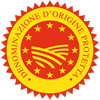Description
The Gamoneu PDO is a fat, seasoned cheese obtained from the unpasteurised milk of Frisian, Asturiana de los Valles, Pardo Alpina cows and crossbreeds. The milk of Lacha, Carranzana, Milschalfe and crossbreds of sheep and the milk of Alpino-Pirenaica and Vabra de los Picos de Europa, Murciano-Granadina, Saanen and crossbreeds of goat. A blend of two or all three types of milk can be used.
Production Area
The production area of Gamoneu PDO is located in the region of the municipalities of Cangas de Onís e Onís, in the Autonomous Community of the Principality of Asturias.
Production Method
The livestock from which the milk is taken is raised on natural resources in the area. Only in exceptional cases and for meteorological reasons cereal and legume concentrates are used. The milk is coagulated with the correct dose of rennet or enzymes, for a period of at least an hour at a temperature of 24-30°C. The curds are broken with care and the paste is then put into cylindrical moulds and lightly pressed. The salting takes place by covering the faces with sodium chloride. The cheeses are then removed from the moulds and undergo the smoking process which must guarantee sufficient drying and the formation of a rind suitable for the penetration of Penicillium during maturation. The seasoning, which lasts at least two months, occurs in chalky grottos or in cellars with an average temperature of 10°C and an average humidity of 90%. During this period, the cheeses are turned and cleaned in such a way as to ensure the development of fungus.
Appearance and Flavour
Gamoneu PDO has a cylindrical shape with flat faces, the diameter varies between 10 and 30 cm and it weighs from 0.5 to 7 kg, the height is between 6 and 15 cm. The rind has a burnt sienna colour after smoking and after the seasoning in a grotto; the appearance of fungus gives it a reddish, greenish, blue tone. The colour of the paste is white or yellow with a slight bluish green at the edge. The consistency of the paste is hard or semihard, solid and crumbly. The aroma has a faint scent of smoke and the smoked flavour is delicate, slightly spicy with a persistent aftertaste of hazelnuts.
History
The production origin of the cheese Gamoneu PDO goes back at least to the 17th century. There are, in fact, documents written at the time which mention the production, some documents addressed to King Philippe IV about pastoral management. Also in other antique documents, there are numerous references to this cheese, defined as a fundamental food for the sustenance of the population.
Gastronomy
The Gamoneu PDO should be kept in a fresh, dry, and well-aired place, once cut the cheese should be put in the least cold area of the refrigerator wrapped in Clingfilm or tinfoil. This cheese is used in the preparation of numerous recipes. It goes very well with chicken and fish-based dishes. It is often used to enrich and flavour risottos, béchamel, vegetable filling, savoury cakes with mushrooms and onion and in the preparation of creams and sauces.
Marketing
The product is sold as Gamoneu PDO, Gamoneu PDO del Puerto (made only in the high mountains passes during the summer months) and Gamoneu PDO del Valle (produced in the valleys all year round). It is sold whole or sliced.
Distinctive Features
The soil and climate conditions of the production area of Gamoneu PDO greatly affect the quality of the pastures on which the required livestock feed. The climate is typically oceanic, with significant rainfall, heavy clouds, and frequent fog while the mountainous terrain is characterised by chalky rocks and quartz modified by erosion.






